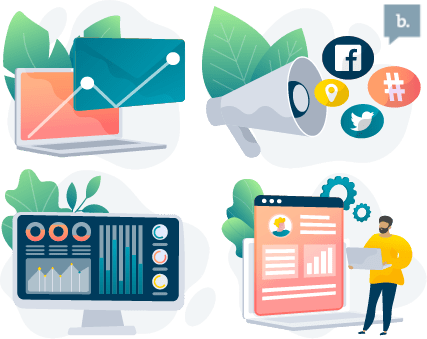Customer tracking is a tactic that allows business owners to know who their customers are, where they live, what their shopping habits are and so much more. One way to do all of that is with customer relationship management (CRM) software. Once you gather this info, though, what do you do with it? You can put it to work for your small business in several useful ways.
Why you should track your customers
There are many reasons why you want to track your customers, but the main one is so your business can better serve them. If you know their spending habits, how often they visit your website, where they're from, and how old they are, you can tailor your business's communications to their specific needs.
Tyler Read, CEO of Personal Trainer Pioneer, said customer tracking allows you to effectively target and serve your customers.
"The information you track about how your customers interact with your brand tells you what they want and when they want it, as well as what their preferences are in terms of payment methods, communicating and receiving communication, and product/service preferences," Read said.
Additionally, customer tracking is important to understand your customers' experiences with your brand, like how someone finds your business, how long it takes them to make a purchase and the lifetime value of the customer.

What you should track
It can be overwhelming at first to decide what the most important things are to track, but some factors can yield better insights than others. Below are the six metrics every business should track:
1. Downloads
Jenna Soard, founder of YouCanLaunch.com, said entrepreneurs should track downloads and opt ins, such as freebies downloaded from landing pages or websites.
"This helps gauge the interest of the lead to determine the target demographics or even psychographics of the lead. When an entrepreneur learns about the traffic or customers coming in, they can produce more content and products that these targets actually want," Soard said.
2. Purchase history
Your own sales data can offer useful customer insights, helping you determine what types of products, services and promotions you could promote in your marketing campaigns.
"Knowing their purchasing history will enable the company to discover the things their customers spend money on," said Michelle Devani, founder of LoveDevani. "As a result, they can offer them products and services of the same kind that can attract them."
3. Customer contact information
Maintain a list of how to reach your customers, such as their email, for instance. Devani said that companies send newsletters or automated messages to their customers contact information so they are aware of the current promotions that the brand has.
"As a result, customers will feel the urge to purchase anything because the promotion entices them," Devani said.
4. Sales funnel
Samantha Moss, editor and content ambassador at Romantific, said that one of the most important things to track is your funnel.
"You must track how many consumers pass through each part of your funnel to identify which part of your process needs to be improved. This will help you create a better process that will convert more leads," Moss added.
5. Traffic channels
Tracking where you're getting your customers from allows you to gauge the return on investment (ROI) of your marketing endeavors accurately, according to Jeff Walker, founder and CEO of Best VPN Canada.
The best way to track this is surveying customers about how they found you or where they heard about you. But there are other options. Soard added that adding tracking pixels or UTM (urchin tracking module) codes to everything is another way to pinpoint where your customers are coming from.
6. Email metrics
Email is a particularly rich source of tracking data. It allows you to track who opens your emails, who doesn't, if they click on anything and, if so, what they click on. These open rates and click-through rates are huge factors in determining how well you are engaging your audience.
If your email marketing campaign is successful, you'll see an open rate of 15% to 25%, and once your customers have opened your emails, you should see a click-through rate of 2.5%-3%.

Customer tracking methods
Now that you know what to look for, the next step is to find a way to track your customers. There are plenty of options; it's really just deciding which one works best for your business. Consider the following:
- Email. If you're using an automated email tool like Mailchimp, you'll be able to track opens, click-throughs, deletes, and other things with your email marketing campaigns. This is helpful because you'll be able to use that information to tailor your email marketing campaign and create more effective email lists.
"You can A/B test messages until you've optimized your email metrics and easily remove or change messaging that is not resonating," said Heather Davis Lam, founder and CEO at Revenue Ops LLC.
- Social media. Social media has been the go-to place for people who are looking for something to purchase, said Devani. Checking who else your customers follow can give you a glimpse of their interests.
Additionally, the insights tool within each of your social media accounts offers a lot of good information about your customers. There, you can usually see which part of the country (or world) they live in, their age and gender. Additionally, you can track engagement and click-throughs.
- Website metrics. Moss said website metrics allow you to see what part of your website gets the most traffic and how consumers behave while they're on your website.
"[Website metrics] are effective because people rely on the internet if they are curious about something and want to learn more about a product or service," said Devani.
For tracking website metrics, Parker Russell, founder of Black Ink Coffee and a U.S. Air Force veteran, said he tracks a few things.
"We track what web pages the customer is using most, what their journey from viewer to customers is and also the pain points," Russell said. "Paint points are very important to acknowledge and resolve."
Russell also suggested tracking how much money they're spending and how they're spending it.
- Customer tracking software. According to Soard, customer relationship management (CRM) software helps you track data such as when a lead opens their emails, when they have clicked on links in emails, or if they have never opened an email.
"A CRM system will allow you to centralize the data you're collecting and create a single source of truth that will enable you to have a 360-degree view of your customer," Lam said. "It will also allow your entire company to access the data necessary to help address customer pain points, build customer loyalty, and create full-funnel reports and dashboards for the company leadership to make data-driven decisions."
Process for tracking customers
Depending on whom you talk to, there is a range of steps involved in tracking customers. The number of steps you implement for your company can depend on the industry you're based in, the size of your business and the resources available, and other factors. Below are four customer tracking processes offered by experts.
1. Segment your email list. Organize your email subscriber list into categories that allow you to more easily identify the different interests of your customers or their place in the sales funnel. You can then segment customers further based on demographics, shopping habits, purchase history, etc.
If you use email marketing software, you can usually segment your list by certain factors, but some companies may charge you extra based on how many segmented lists you have, so choose wisely.
2. Create customer tags. Customer tags are lines of code embedded in your website that track customers and gather information like how long visitors stay on your website, what products they've viewed and added to their cart, and removed from their cart.
Coding these tags isn't easy for someone without experience, but resources like Google Tag Manager can make it easier, especially since you'll want to add more than one tag to a customer.
3. Track pixels. Pixels, too, are lines of specific code inserted into your website's code. They can be placed on images, links or other areas. Once those codes are in there, you can track website visits, ad impressions, conversions, and how consumers arrived at your business's website.
You want to include tracking pixels on all of your landing pages, web pages, and purchase confirmation pages to optimize paid advertising.
4. Review customer tags and lists. You can add tags to certain customers, similar to how you would add a hashtag to a photo on social media. You can tag customers based on interests, but also on other demographics and habits. If you already use a CRM, using the data you've collected through tags and segmented email lists should be easy.
Using customer tags can show you the results of your promotions to see if they're working. You can also apply the same principles for your less active customers, to see how you can tailor an email retargeting campaign if need be.
There are some alternative approaches you might want to consider for your small business. Here's another example that Moss provided:
- Create your business's customer journey based on buyer personas.
- Find the points at which consumers interact with your brand.
- Create a visual map of your customers' journey.
- Identify if your customers are reaching their goals.
- Review your customer journey map and make any needed changes.
If you're looking for a more technical approach, Read offered this process:
- Decide on the system you'll use for customer tracking (e.g., CRM software, email marketing software).
- Implement your customer tracking system with clearly defined methods, procedures, and goals.
- Train all relevant team members on your system, methods, procedures and goals.
- Begin tracking customer information and interactions.
- Analyze the data tracked to see how you can better serve customers.
- Use the analyzed data to improve processes, marketing, retargeting, and products for all current and future customers.
None of these examples is necessarily better than another one, but it's good to have options so you can implement a process that works best for your business, which is the No. 1 goal.
"[W]hen you're tracking [customers] behaviors well, you get the power to peek at what they think and feel about your business," said Walker.